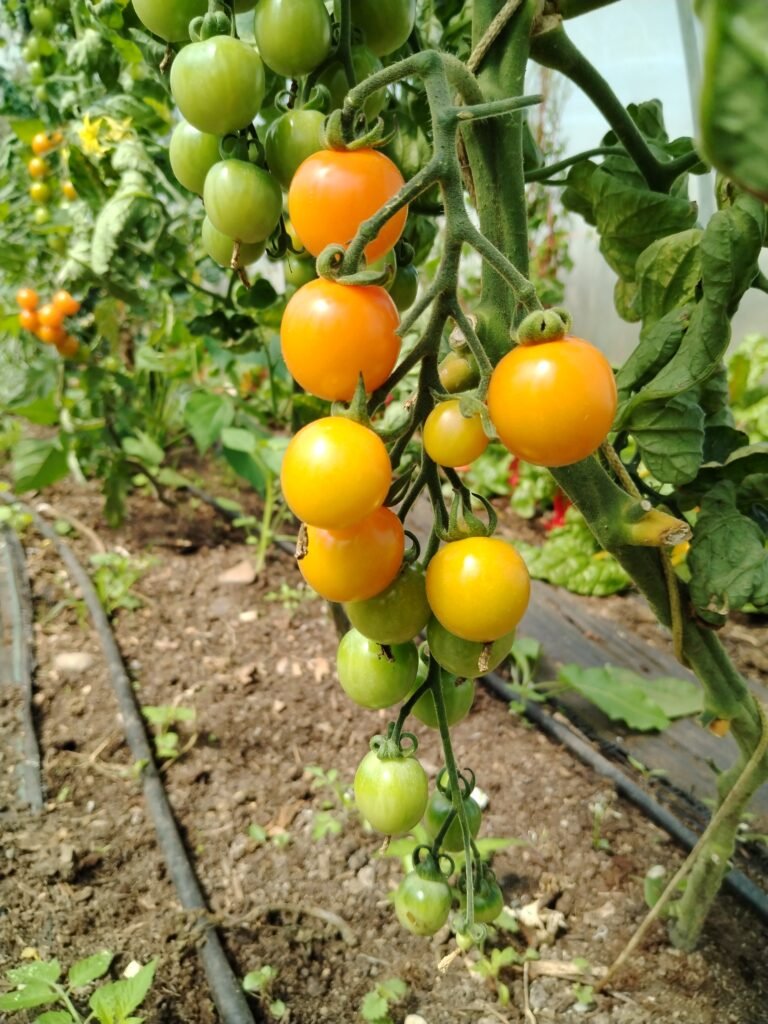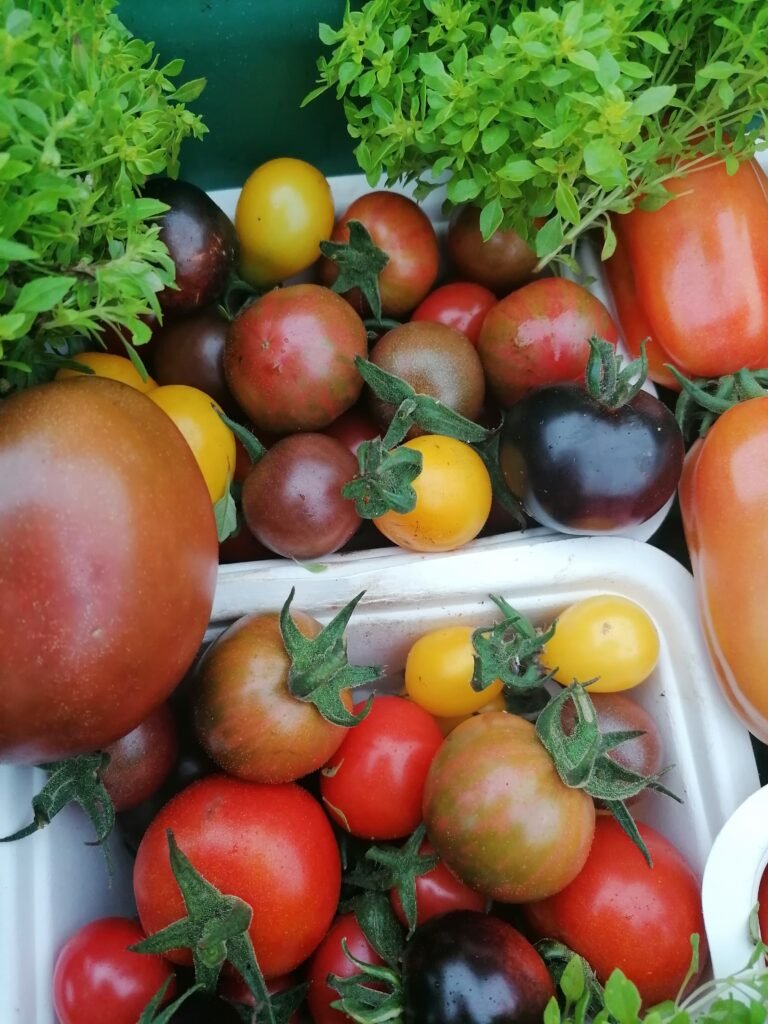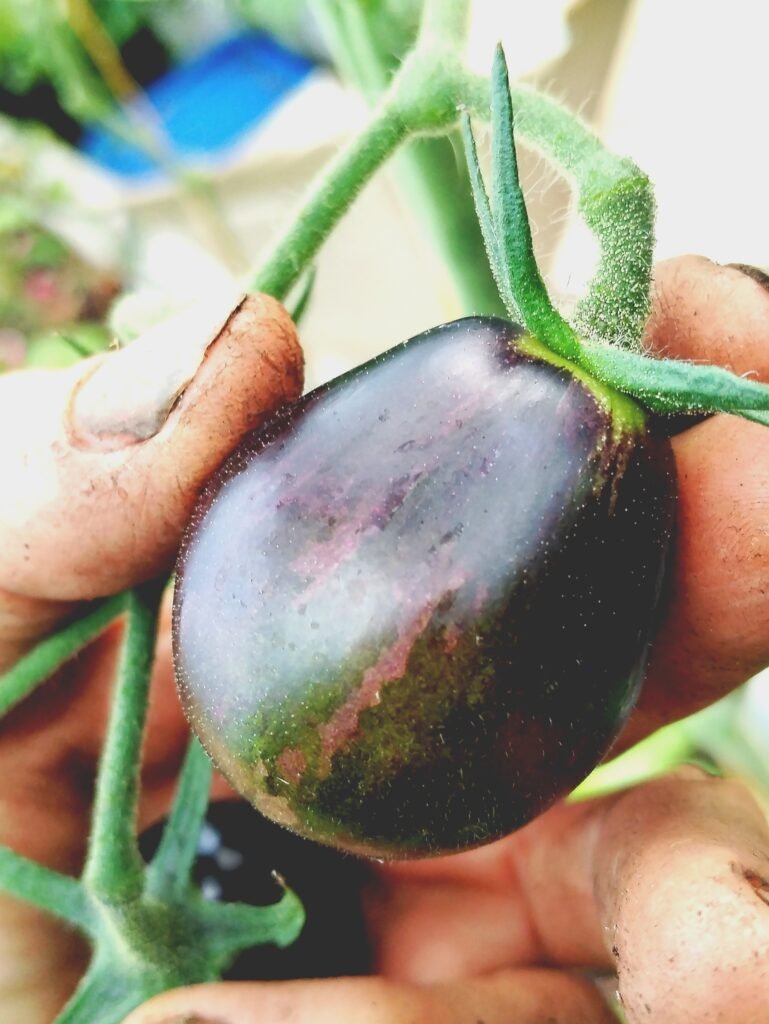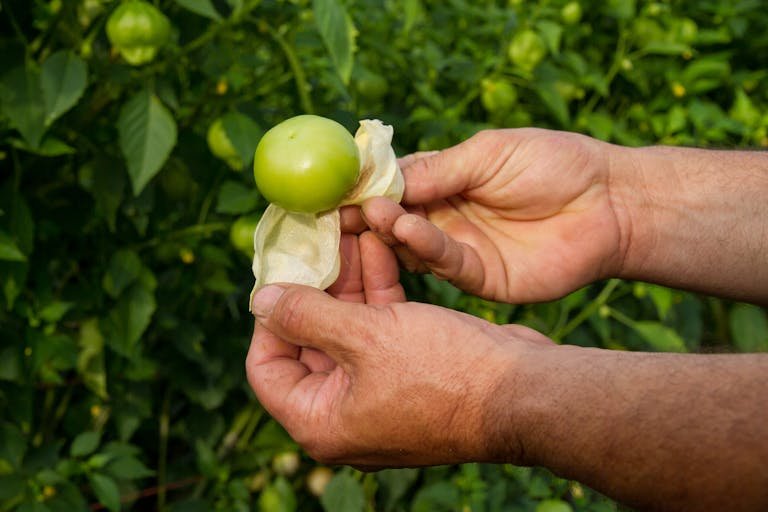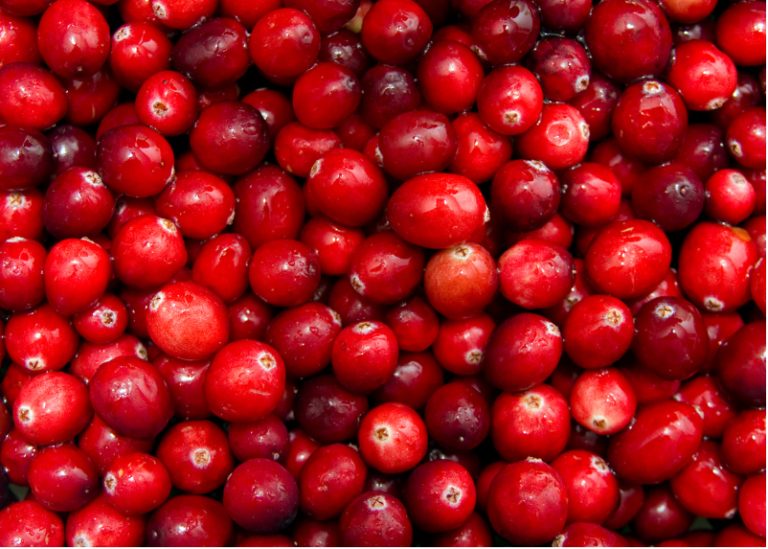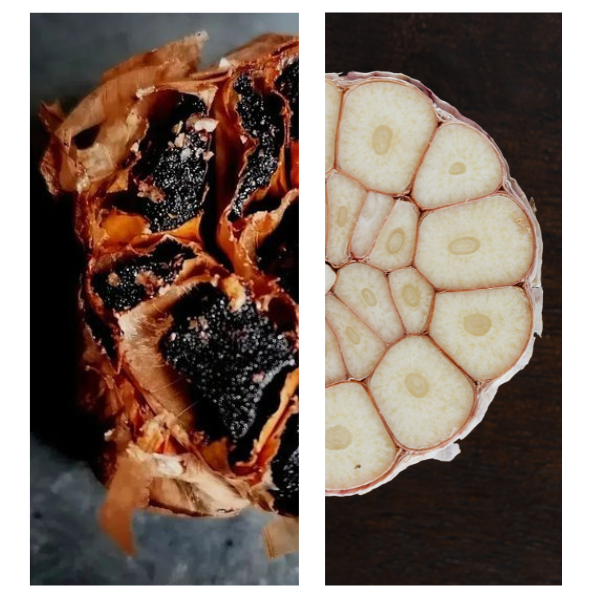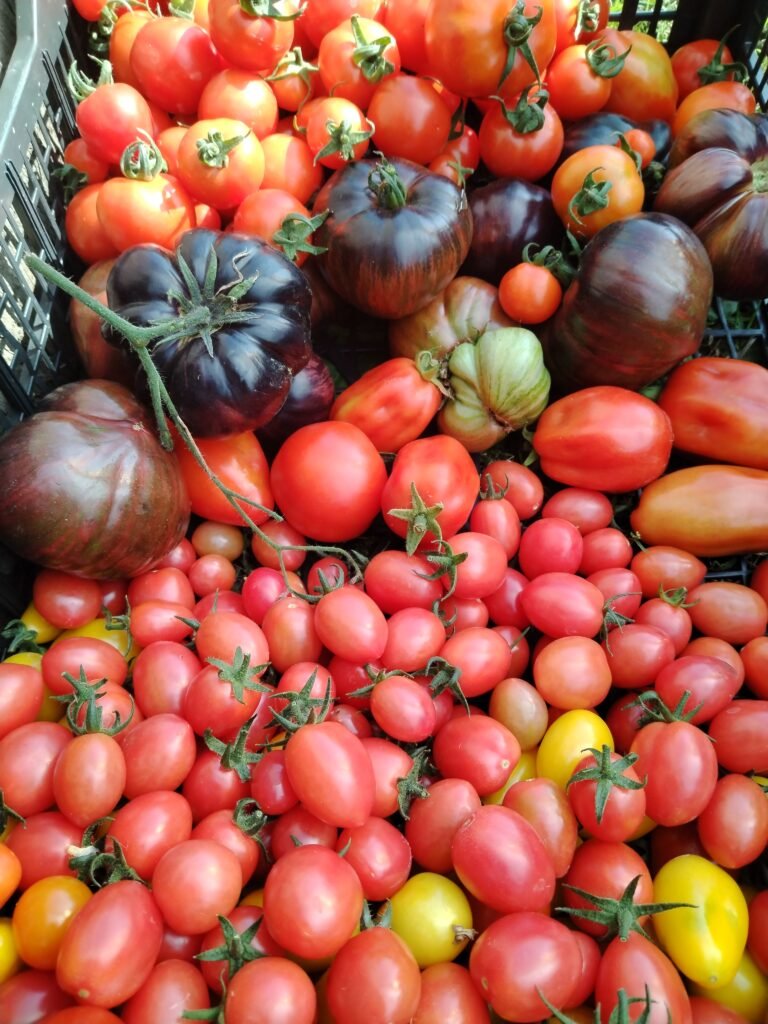If you’ve ever bitten into a sun-warmed tomato straight from the vine, you already know this truth: the types of tomatoes you grow at home taste worlds apart from anything lined up in a supermarket aisle. There’s a kind of magic in that first bite—sweet, sharp, juicy, and full of the sunshine that helped it ripen. No mealy texture. No bland afterthought. Just real tomato.
And the best bit? When you grow your own, you get to choose. There’s a type of tomato for every craving and kitchen job—chunky beefsteaks for sandwiches that need a sturdy slice, plump Romas that simmer into rich, thick sauces, tiny cherries that never even make it inside the house. (In fact, Gar’s been known to wander the polytunnel snacking on them like sweets while checking the plants—his favourite mid-task treat.)
Each type comes with its own quirks and superpowers in the garden too, from vigorous vines to tidy little bushes perfect for a patio pot. Growing your own gives you more than flavour—it gives you control. You decide if you want to preserve, snack, roast, or slice. You choose disease-resistant varieties that suit your space and climate. And best of all, you grow the kind of tomato that never needs a barcode.
So if you’ve been sticking to one-size-fits-all tomato plants, it’s time to branch out. Let’s walk through the six main types of tomatoes and how to grow each one like a pro.
Some of the links in this post are affiliate links, including links to products on Amazon. This means if you click and make a purchase, I may earn a small commission at no extra cost to you. I only recommend items I genuinely love and believe could add value to your life. Thank you for supporting this blog—it helps keep the content free and full of ideas just for you!
Beefsteak Tomatoes – The Big and Bold Giants
There’s nothing shy about a beefsteak tomato. These are the heavyweights of the tomato world—thick-skinned, meaty, and bursting with juice. When they ripen in the garden, they practically glow, begging to be sliced thick for a late summer sandwich or layered into a caprese straight from the vine. We always make room for a few in the tunnel—nothing beats the satisfaction of growing a tomato bigger than your palm.
Large, meaty fruit ideal for slicing
Beefsteaks are the ones to grow if you want serious heft. One slice is often enough to cover a whole sandwich, and they’re perfect for summer meals that need a bit of wow factor. Their dense, fleshy texture means less mess, more bite.
Best for: burgers, sandwiches, and fresh eating
These beauties are at their best raw—just a sprinkle of sea salt and a drizzle of olive oil and you’ve got lunch. We love using them for burgers or open-faced toasties from the garden. If you’re into rustic garden feasts, this is your go-to tomato.
Require strong support and staking
Beefsteak plants are big, bold, and not shy about sprawling. They’ll need proper staking to stop them toppling over. A sturdy tomato cage, strong bamboo canes, or even a purpose-built tomato frame (like this heavy-duty support system) will keep them upright and happy through the season.
Thrive in warm, protected environments
Beefsteaks are sun-lovers and need consistent warmth to reach their full potential. They do beautifully in polytunnels, greenhouses, or under a warm wall if you’re lucky. We’ve had great results growing them under cover with a quality tunnel setup, especially in cooler climates.
Popular varieties: Brandywine, Marmande, Big Boy
There’s a lot to love in the beefsteak category, but we keep coming back to these three. Brandywine has that rich heirloom flavour, Marmande is ideal for Irish tunnels, and Big Boy lives up to its name with impressive yields and classic good looks.
Cherry & Grape Tomatoes – The Sweet Snackers
If there’s one tomato that barely makes it to the kitchen, it’s the cherry. Or the grape. Or whichever sweet little orb Gar’s snacking on while he “checks on things” in the garden. These are the pop-in-your-mouth types that never last long. They come in all shades—from sunshine yellow to deep, moody purple—and they’re as pretty as they are addictive. For kids, lunchboxes, and gardeners with no self-control (hi, that’s us), these are a must-grow.
Small, bite-sized fruits in red, yellow, orange, or even black
Tiny but mighty, these fruits come in a rainbow of colours and flavours. Cherry tomatoes tend to be rounder and juicier, while grape types are slightly meatier and oval-shaped—ideal for those who like a bit of crunch with their sweetness. Variety makes them ideal for both show-stopping salads and joyful snacking straight from the vine.
Excellent for fresh snacking, salads, and kids’ lunchboxes
Honestly, they’re like nature’s sweets. Whether tossed into a pasta salad, skewered on a BBQ stick, or handed to a toddler mid-meltdown, cherry tomatoes have a way of disappearing fast. Try mixing red and yellow varieties for a cheerful bowlful that looks as good as it tastes.
Vigorous growers—can be indeterminate or bush-type
These plants don’t mess about. Some climb like wild things, while others stay compact and bushy. If you’re tight on space, go for a dwarf or patio variety. Otherwise, let them ramble up a trellis or frame with the help of a tidy tomato ladder or twine support system.
Great in containers or beds
No garden? No problem. Cherries and grapes are perfectly happy in pots, hanging baskets, and grow bags. Just be sure they’ve got good drainage and a sunny spot. We’ve grown them on windowsills, balconies, and in tucked-away corners of the tunnel.
Varieties: Sungold, Black Cherry, Sweet Million
Sungold is sunshine in a bite—sweet, tangy, and golden orange. Black Cherry brings that moody heirloom vibe with rich flavour, and Sweet Million lives up to its name with clusters upon clusters of fruit. Grow all three and you won’t regret it.
Plum & Roma Tomatoes – The Sauce-Makers’ Choice
If cherry tomatoes are for popping into your mouth, plum and Roma types are for popping into the pot. These are the workhorses of the kitchen—meaty, low-moisture, and packed with rich, concentrated flavour. They’re the ones we reach for when it’s time to bottle up summer. Homemade ketchup, thick sauces, roasted tomato paste… this is where they shine.
Thick-walled, less watery—perfect for cooking
Plum and Roma tomatoes are bred for structure. Their dense, fleshy interiors mean less simmering time and more punch per spoonful. If you love batch cooking or dream of jars lined up on the pantry shelf, these are the tomatoes for you.
Ideal for sauces, pastes, ketchup, and preserving
While slicing tomatoes collapse in a watery mess on the pan, Romas hold their own. We use them for everything from slow-roasted tomato confit to big-batch pasta sauce. If you’ve never tried your own homemade ketchup, you’re in for a treat. They’re also easy to freeze whole—just wash and bag.
Often determinate; bushy, compact growth
Unlike their viney cousins, many Romas and plums are determinate, meaning they grow to a set height and ripen all at once. That makes them ideal for short-season growers or anyone wanting a single, satisfying harvest. Their bushy shape is great for smaller spaces and raised beds.
Require good airflow to prevent blossom end rot
One thing to watch? Good air circulation. Their dense clusters and compact habit can make them prone to blossom end rot if airflow is poor or watering is uneven. Raised beds with open-sided tomato cages or low tunnel hoops can help keep things breezy and balanced.
Varieties: San Marzano, Amish Paste, Roma VF
San Marzano is the darling of Italian sauce-makers, with a sweet, complex flavour and elegant shape. Amish Paste is a plump heirloom with real garden charm, and Roma VF is a disease-resistant classic that rarely disappoints. Grow a mix and get bottling.
Globe Tomatoes – The All-Purpose Workhorses
If you’ve ever grown a tomato that felt like an old reliable friend—dependable, unfussy, and always welcome at the table—it was probably a globe type. These are your classic round, medium-sized tomatoes, found everywhere from grocery stores to granny’s garden. But grown at home, their flavour jumps up several notches, and their versatility makes them a favourite for beginner gardeners and busy cooks alike.
Standard supermarket shape—medium round
Globe tomatoes are what most people picture when they think “tomato.” They’re round, medium-sized, and often bright red, although some heirlooms come in yellows or stripes. Their even size and shape make them a dream for slicing and dicing—no awkward lumps or surprises inside.
Balanced flavor, good for slicing, salads, and cooking
What makes globe tomatoes so handy is their balance. Not too sweet, not too tart, not too watery—just right. Whether you’re chopping them into a salsa, layering them into a grilled cheese, or simmering a quick pasta sauce, they’ll rise to the occasion without stealing the show.
Easy to grow; ideal for beginners
Because they don’t have many diva tendencies, globe types are a great starting point for new growers. They’re forgiving of small mistakes, grow steadily, and produce well in most garden setups. If you’re setting up your first raised bed or just figuring out your watering schedule, these won’t let you down.
Can be determinate or indeterminate
Here’s where it gets flexible—some globe varieties grow like neat little bushes (determinate), while others vine and ramble (indeterminate). You can choose based on your space and time: determinate types for compact gardens and quick harvests, indeterminate ones for a longer season of picking.
Varieties: Moneymaker, Celebrity, Rutgers
Moneymaker has earned its name with consistent yields and cheerful flavour—perfect for salads. Celebrity is a semi-determinate wonder, offering disease resistance and neat growth. Rutgers is an old favourite that dates back to the 1930s, with rich flavour and thick skin that holds up to slicing and stuffing.
Oxheart Tomatoes – The Romantic Heirlooms
If tomatoes had a love story, the oxheart would be its leading character—old-fashioned, poetic, and slightly dramatic in the best possible way. These heart-shaped beauties have been passed down through generations, cherished not just for their rich, sweet flavour but for their sheer presence in the garden. They may not be the easiest to grow, but oh, are they worth it.
Heart-shaped, large and fleshy with few seeds
True to their name, oxheart tomatoes swell into a generous, heart-like shape. They’re often lumpy and delightfully imperfect, with thick flesh and barely any seeds. That means less fuss in the kitchen and more delicious tomato per bite—ideal for those who hate the mess but love the flavour.
Rich, sweet flavor, perfect for raw eating and roasting
Oxhearts don’t shout; they sing. Their sweetness is more floral than sugary, and they shine best when eaten fresh—perhaps with just a sprinkle of sea salt and a drizzle of olive oil. That said, a slow roast brings out their natural sugars beautifully. They make an incredible tomato tart or a rustic galette.
Indeterminate; may require careful pruning
These are vining plants, and they like to stretch out and explore. Because of their size and weight, they benefit from regular pruning to improve airflow and avoid branches snapping under the load. It’s a small bit of maintenance that makes a big difference in yield—and plant happiness.
Not ideal for small spaces due to large size
Because of their growth habit, oxhearts really do best when they’ve got room to breathe. They’re not a great fit for small patios or cramped beds. However, if you’ve got a tunnel, greenhouse, or even a dedicated corner in a larger plot, you can absolutely let them sprawl and shine. Trellises or heavy-duty tomato cages can go a long way in keeping them upright and productive.
Varieties: Anna Russian, Cuore di Bue, Hungarian Heart
If you’re looking for an old-world tomato with serious culinary charm, Cuore di Bue (Italian for “ox heart”) is a classic. Anna Russian is a cold-hardy heirloom that thrives even in unpredictable weather, while Hungarian Heart delivers big yields of dense, juicy fruit that are perfect for preserving or slicing into thick, indulgent slabs.
Pear Tomatoes – The Charming Little Elves
Playful in shape and cheerful in colour, pear tomatoes are the kind of crop that makes gardening feel like pure joy. These miniature charmers are ideal for nibbling straight from the vine—Gar swears by them as his go-to snack while weeding or fixing fence posts. Despite their dainty size, they’re surprisingly productive and versatile, especially for small-space growers and container gardeners.
Small, cute, and shaped like their namesake
There’s something irresistibly whimsical about a tomato shaped like a tiny pear. These little fruits grow in clusters and seem to dangle like ornaments from the vine. Their petite size makes them perfect for adding visual interest to dishes—and gardens too.
Mild, sweet flavor; good for drying and fresh snacking
Not overly acidic or tangy, pear tomatoes have a gentle sweetness that makes them a favourite among children and snack-loving gardeners. They’re also a dream for preserving—cut them in half and slow-roast or dehydrate for a sweet, chewy treat that tastes like tomato candy.
Available in yellow, red, and orange
These tomatoes are as colourful as they are charming. Yellow Pear is the classic—sunny, mellow, and sweet. Red Fig offers a bit more acidity and depth, while Orange Banana (despite the name) keeps things mild with a pop of citrusy colour. Mixing colours in a bowl or salad brings a joyful, garden-fresh aesthetic to the table.
Grow well in pots and hanging baskets
One of their biggest perks? They’re compact and adaptable. Whether you’re short on space or just want a cheerful hanging display, pear tomatoes do well in pots, hanging baskets, or even tucked into raised beds. A sturdy hanging tomato planter or self-watering pot will help them thrive with minimal fuss.
Varieties: Yellow Pear, Red Fig, Orange Banana
All three are reliable, heirloom favourites, each with its own personality. Try a mix and let the garden become a painter’s palette—one you can snack on daily.
Choosing the Right Type for Your Garden Setup
With so many types of tomatoes dangling temptingly on the seed rack, how do you decide which ones truly belong in your garden? Thankfully, it’s not about choosing the best tomato—it’s about choosing the right one for your space, needs, and tastebuds. And once you start matching tomatoes to your growing style, everything falls deliciously into place.
First and foremost, consider space. If you’re gardening on a balcony or have limited room, compact varieties like cherry or pear tomatoes are your best friends. They’re vigorous without being unruly and thrive in containers, hanging baskets, and tidy raised beds. On the other hand, if you’ve got sprawling beds or the luxury of a polytunnel, beefsteaks and oxhearts can stretch their leafy limbs and reward you with hefty, flavour-packed harvests.
Next, think about sunlight and support. Most tomatoes adore full sun—ideally 6–8 hours daily—and some need more structure than others. Tall, indeterminate types like globe or oxheart tomatoes will need sturdy stakes, cages, or even a trellis. Meanwhile, determinate types like Roma or Celebrity tend to bush out and require less pruning, which can save time and effort.
Also, ask yourself: what’s the goal? If it’s sandwiches and slicing, you’ll want meaty giants like Brandywine. For preserving, choose paste-friendly plums. And for snacking while you work (Gar’s specialty), a mix of cherries and pears might be all you need.
Finally, consider timing and diversity. Plant a mix of early, mid, and late varieties for a season-long harvest, and don’t forget to tuck in a few fragrant companions like basil or marigold to keep pests in check and flavours singing.
In short: your perfect tomato patch isn’t one-size-fits-all. It’s a love letter to your space, your meals, and your style of growing.
Conclusion: Tomatoes Tailored to You
At the end of the day, growing tomatoes isn’t just about the harvest—it’s about finding joy in the process, from seed to sandwich. And with so many types of tomatoes to choose from, you’re never stuck with just one kind of fruit. Instead, you get to curate your own tomato patch, where every variety plays a role—whether that’s a juicy beefsteak for burgers, a sweet cherry for snacking, or a thick Roma for the perfect pasta sauce.
But here’s the real beauty: growing your own tomatoes means you call the shots. You get to decide what flavours end up on your plate, how your plants are grown, and even what colours pop in your garden. You’re not limited to the bland, uniform tomatoes from the supermarket—no, you get the full rainbow of tastes, textures, and shapes.
So whether you’re tending a row of vines in a tunnel or dotting your patio with cheerful pots, there’s a tomato that fits just right. And if you’re still unsure about the nitty-gritty of growing them—when to start, how to prune, what to feed—don’t worry. You’ll find all that (and more) in our full How to Grow Tomatoes Guide.
Now, take what you’ve learned here and picture your dream tomato patch. Chances are, it’s not only possible—it’s right around the corner, waiting to be planted.

